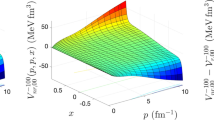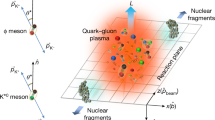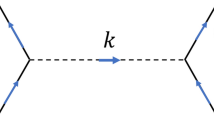Abstract
As was first pointed out by Yukawa, it is in principle possible to account for the short-range forces between nuclear particles by the assumption of virtual emission and absorption processes involving intermediary particles of integral spin, the so-called mesons1, the mass of which is determined by the range of the forces. As has been shown by Kemmer2, the simplest wave-equations for the mesons which satisfy, besides the claim of relativistic invariance, the condition of giving a positive definite expression for the energy, reduce to four types, characterized by different co-variance properties of the wave-functions, and each allowing the existence of neutral as well as positively and negatively charged mesons. Starting from such wave-equations, including the interaction of the meson field with the heavy nuclear constituents, the estimation of the resulting expressions for the nuclear forces has hitherto been carried out by using the ordinary perturbation method of quantum theory, and taking into consideration only the first non-vanishing approximation, in spite of the well-known lack of convergence of the method. It would thus seem desirable to discuss more closely the reliability of such results, and for this purpose a possible method of attack is suggested by an analogous situation in quantum electrodynamics, where a suitable canonical transformation allows us to separate, from the expression of the total energy of a system consisting of electrons and an electromagnetic field, a term depending only on the coordinates of the electrons and representing the Coulomb potential energy.
This is a preview of subscription content, access via your institution
Access options
Subscribe to this journal
Receive 51 print issues and online access
$199.00 per year
only $3.90 per issue
Buy this article
- Purchase on Springer Link
- Instant access to full article PDF
Prices may be subject to local taxes which are calculated during checkout
Similar content being viewed by others
References
See Bhabha, NATURE (in the Press).
Kemmer, Proc. Roy. Soc., A, 166, 127 (1938); Proc. Camb. Phil. Soc., 34, 354 (1938).
Independently of our work, essentially the same method has been proposed by Stückelberg (Phys. Rev., 54, 889; 1938), to whom we are very thankful for the kind communication of his manuscript.
Yukawa, Sakata, Kobayasi, Taketani, Proc. Phys. Math. Soc. Japan, 20, 720 (1938).
Author information
Authors and Affiliations
Rights and permissions
About this article
Cite this article
MØLLER, C., ROSENFELD, L. Theory of Mesons and Nuclear Forces. Nature 143, 241–242 (1939). https://doi.org/10.1038/143241a0
Published:
Issue Date:
DOI: https://doi.org/10.1038/143241a0
This article is cited by
-
A terminological history of early elementary particle physics
Archive for History of Exact Sciences (2023)
-
The Theory of Nuclear Forces*
Nature (1940)
-
Theory of Mesons and Nuclear Forces
Nature (1939)
-
The Electric Quadrupole Moment of the Deuteron and the Field Theory of Nuclear Forces
Nature (1939)
-
Connexion between the Life-time of the Meson and the Beta-Decay of Light Elements
Nature (1939)
Comments
By submitting a comment you agree to abide by our Terms and Community Guidelines. If you find something abusive or that does not comply with our terms or guidelines please flag it as inappropriate.



